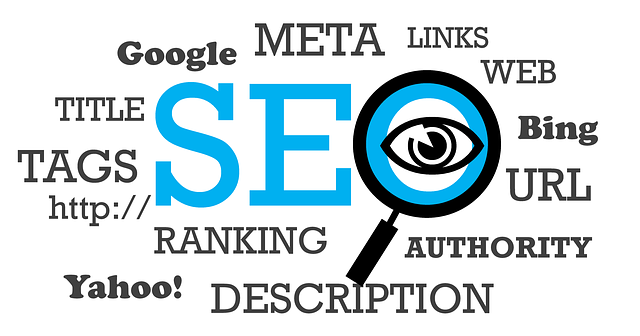Content optimization is a powerful SEO strategy that boosts website visibility and rankings by creating valuable, keyword-rich material tailored to user needs. Key tactics include thorough keyword research to identify target audience terms, natural incorporation of these keywords throughout content, and crafting high-quality, engaging content that provides substantial value. On-page SEO optimization involves balanced keyword density, compelling meta descriptions, and clean user experiences with strategic internal linking. Improving user experience through optimized navigation, fast loading times, and consumable content reduces bounce rates and increases engagement, signaling search engines of your content's quality and relevance. Earning high-quality backlinks from reputable sources and using analytics tools to track content performance are also crucial SEO Tips for Ranking Higher.
Content Optimization is a powerful tool for boosting your online presence and ranking higher on search engines. This comprehensive guide delves into the essential strategies, from SEO tips for ranking higher through keyword research, on-page optimization, user experience enhancement, and building quality backlinks. By mastering these techniques, you’ll learn how to craft high-quality content that resonates with your audience while attracting search engines’ favor. Discover how to measure content performance and consistently refine your approach for ongoing SEO success.
Understanding Content Optimization for SEO

Content optimization is a crucial aspect of Search Engine Optimization (SEO) that involves enhancing your website’s content to improve its visibility and ranking on search engine result pages (SERPs). It’s not just about stuffing keywords; rather, it’s an art of creating valuable, relevant, and engaging content tailored to meet the needs and intent of your target audience. By understanding user behavior and search patterns, you can optimize your content to align with what people are searching for, thereby increasing the likelihood of ranking higher on Google and other search engines.
One effective SEO tip for ranking higher is conducting thorough keyword research to identify relevant terms and phrases that your target audience uses when searching online. Incorporate these keywords naturally into your headlines, subheadings, meta descriptions, and throughout your content without appearing spammy. Additionally, focus on creating high-quality, unique content that provides substantial value, answers questions, or solves problems for your readers, encouraging them to stay longer on your page and potentially share it with others.
Keyword Research: The Cornerstone of SEO Success

Keyword research is an essential aspect of content optimization, serving as the cornerstone for any successful SEO strategy. It involves a thorough understanding of your target audience and their search behaviors. By identifying relevant keywords and phrases that users commonly search for, you can create content that resonates with your ideal viewers. This process ensures that your website appears in search engine results when potential customers are actively looking for products or services related to your niche.
Using SEO tips like keyword research allows you to stay ahead of the competition. It enables you to optimize your content effectively, making it more visible and relevant to search engines. Incorporating these keywords naturally into your writing improves your site’s ranking, driving more organic traffic to your pages. This strategic approach is vital for long-term SEO success, as it helps establish a strong online presence and fosters better connections with your target market.
Crafting High-Quality, Relevant Content

Creating high-quality, relevant content is a cornerstone of effective content optimization strategies designed to boost your site’s ranking on search engines. When crafting content, it’s essential to align it with what your target audience is searching for and what search algorithms prioritize. Start by conducting thorough keyword research to identify terms and phrases that your ideal readers use when looking for information related to your niche. Incorporate these keywords naturally throughout your content—in headings, subheadings, meta descriptions, and the main body text.
Remember, quality should never be compromised for quantity. Focus on providing in-depth, valuable insights that address your audience’s needs and questions comprehensively. Engaging, informative content not only satisfies user intent but also encourages longer visits, lower bounce rates, and increased time spent on site—all of which are factors that search engines consider when determining a website’s authority and relevance. Implementing these SEO tips for ranking higher ensures your content not only attracts organic traffic but also establishes your brand as a trusted source in your industry.
On-Page SEO Best Practices

When it comes to on-page SEO, best practices involve optimizing key elements to enhance search engine visibility and user experience. One crucial tip is to conduct thorough keyword research to identify relevant terms your target audience uses when searching for your content. Incorporate these keywords naturally throughout your text, focusing on both the page title and headings (H1, H2, etc.), ensuring a balanced and readable structure. This strategy, known as keyword density, signals search engines about your content’s relevance without appearing spammy.
Additionally, crafting compelling meta descriptions is essential for SEO tips that boost rankings. These brief summaries appear in search results, enticing users to click through. A well-written meta description should include keywords while highlighting the value and uniqueness of your content. Remember, a clean, uncluttered layout with easy-to-read fonts and relevant internal linking can significantly improve user engagement, telling search engines that your page offers a positive browsing experience.
Leveraging User Experience for Better Rankings

Improving user experience is a powerful SEO tip for ranking higher. Websites that offer seamless navigation, quick loading times, and easily consumable content tend to capture and retain users’ interest better than their clunky counterparts. Search engines like Google have long emphasized the importance of user satisfaction as a core part of their algorithms. By enhancing your site’s structure and design, you can reduce bounce rates and increase time spent on page, which signals to search engines that your content is valuable and relevant.
This approach not only improves your website’s visibility in search results but also fosters a positive perception of your brand. Happy users are more likely to become loyal followers, share their experiences with others, and return to your site repeatedly. Incorporating user-centric SEO tips into your strategy ensures that your content is not only optimized for search engines but also tailored to meet the needs and expectations of your target audience.
Building Quality Backlinks: A Strategic Approach

Building quality backlinks is a strategic and essential component of any effective SEO tips for ranking higher. It involves securing high-quality, relevant links from reputable websites that point back to yours. This process can be achieved through various tactical approaches such as creating compelling content that naturally attracts links, collaborating with industry influencers, or participating in guest blogging on established platforms. The quality and relevance of these backlinks significantly impact your site’s authority and search engine rankings.
When implementing SEO strategies, it’s crucial to focus on earning backlinks rather than buying them. Search engines like Google have evolved algorithms to penalize sites with artificial link profiles. Earning backlinks through genuine efforts not only enhances your site’s credibility but also ensures a more sustainable ranking position over time. Remember, each backlink should contribute to the overall relevance and authority of your website, ultimately strengthening its online presence.
Measuring and Analyzing Content Performance

Measuring content performance is a crucial step in optimizing your digital assets for better search engine rankings. By utilizing analytics tools, you can gain valuable insights into how your audience engages with your content, enabling data-driven decisions to enhance SEO strategies. Track key metrics such as page views, bounce rates, and average session durations to identify top-performing pieces of content that resonate with your target demographic.
Leveraging these analytics offers a competitive edge by revealing areas for improvement. For instance, low engagement metrics might signal the need for more compelling headlines or calls to action. Understanding user behavior through heatmaps and clickstream data can further guide refinements to structure and placement of content elements, ultimately contributing to SEO tips for ranking higher and driving organic traffic.
